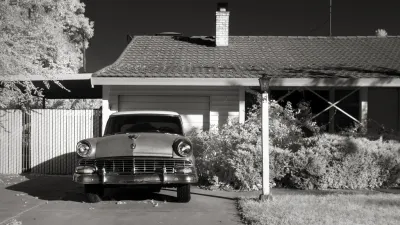The nation has a huge quantity of postwar housing that can be made more walkable and appealing to new generations of residents. Robert Steuteville examines what makes them good candidates and notes some examples of successful retrofits.

"World War II has long been considered the watershed for automobile-oriented development. Suburbs were built prior to the war, but largely were mixed-use, walkable towns and neighborhoods of the 'streetcar suburb' variety."
"After 1945, development shifted radically — to automobile-oriented housing with various types of single-use commercial development along arterial highways."
"Yet this binary view — traditional neighborhoods before the war; suburban sprawl afterward — obscures differences in postwar suburban patterns that can exert a critical impact on revitalization. Planners and theorists have in recent years been debating how to fix the suburbs, as discussed in books such as Retrofitting Suburbia by Ellen Dunham-Jones and June Williamson, and Sprawl Repair Manual by Galina Tachieva. This year, Arthur C. Nelson in Reshaping Metropolitan America made the demographic case that redevelopment of low-density commercial buildings – largely in the suburbs — could meet all of the US new housing needs in the coming decades."
"As successful case studies pile up, demonstrating the high returns generated by redevelopment associated with Leave it to Beaver neighborhoods," concludes Steuteville, "more public funds could be allocated into remaking the 'corridors of crap' into main streets. This, in turn, could generate momentum for bringing new life to the suburbs built after World War II and make US metropolitan regions more sustainable, appealing, and economically viable."
FULL STORY: Postwar neighborhoods are key to suburban revitalization

Analysis: Cybertruck Fatality Rate Far Exceeds That of Ford Pinto
The Tesla Cybertruck was recalled seven times last year.

National Parks Layoffs Will Cause Communities to Lose Billions
Thousands of essential park workers were laid off this week, just before the busy spring break season.

Retro-silient?: America’s First “Eco-burb,” The Woodlands Turns 50
A master-planned community north of Houston offers lessons on green infrastructure and resilient design, but falls short of its founder’s lofty affordability and walkability goals.

Test News Post 1
This is a summary

Analysis: Cybertruck Fatality Rate Far Exceeds That of Ford Pinto
The Tesla Cybertruck was recalled seven times last year.

Test News Headline 46
Test for the image on the front page.
Urban Design for Planners 1: Software Tools
This six-course series explores essential urban design concepts using open source software and equips planners with the tools they need to participate fully in the urban design process.
Planning for Universal Design
Learn the tools for implementing Universal Design in planning regulations.
EMC Planning Group, Inc.
Planetizen
Planetizen
Mpact (formerly Rail~Volution)
Great Falls Development Authority, Inc.
HUDs Office of Policy Development and Research
NYU Wagner Graduate School of Public Service

























